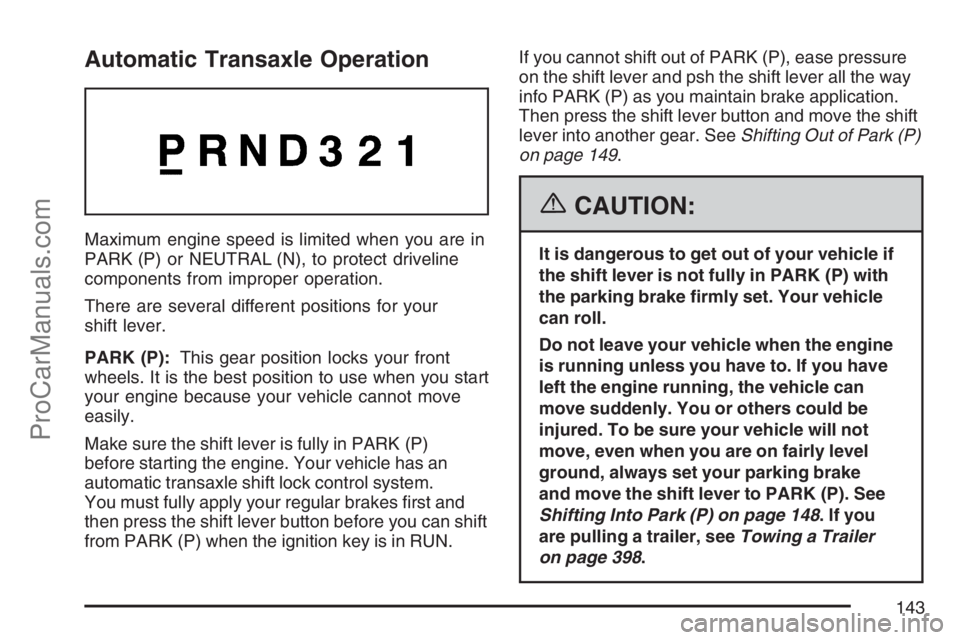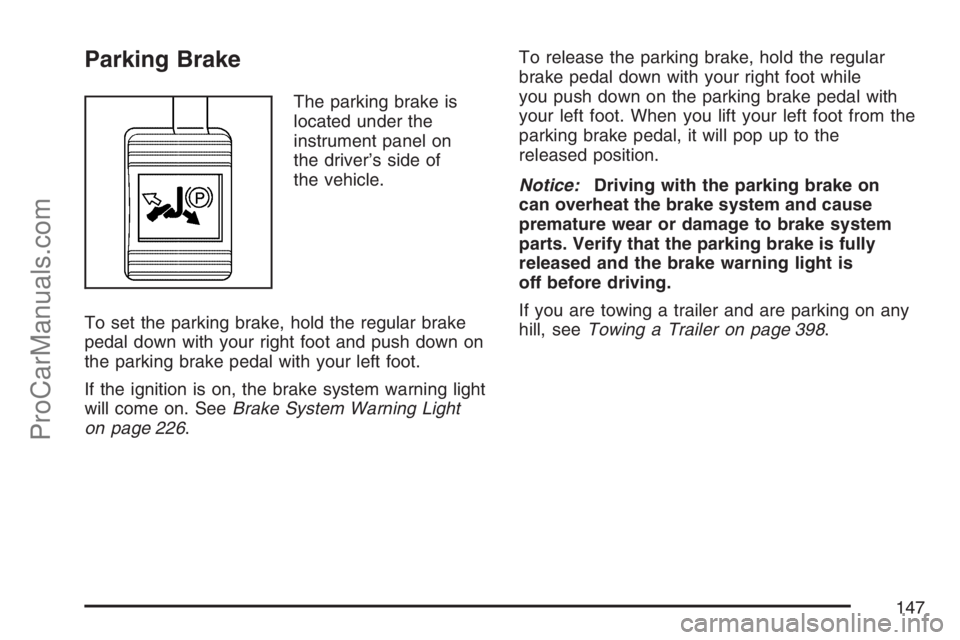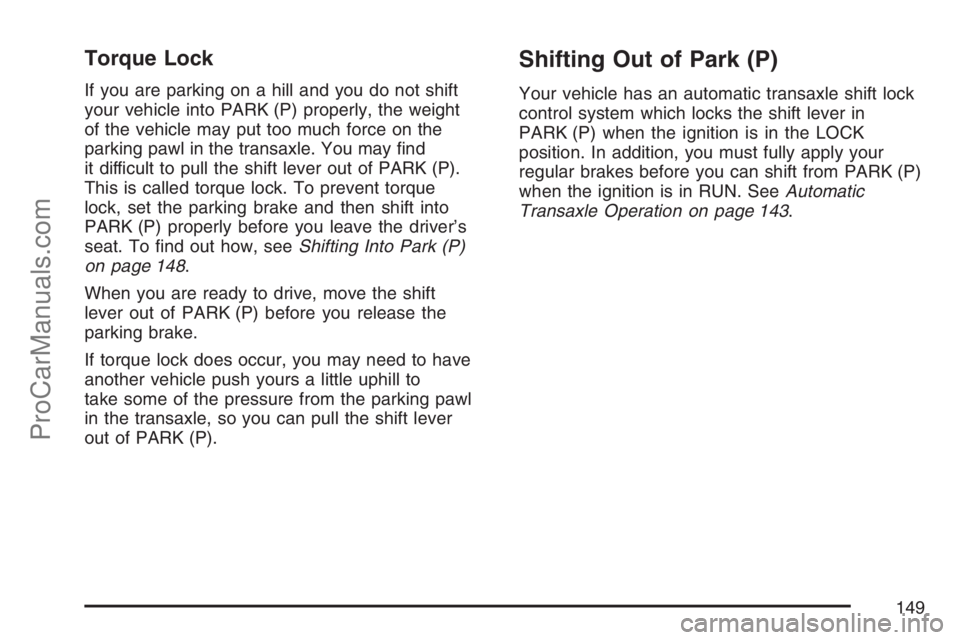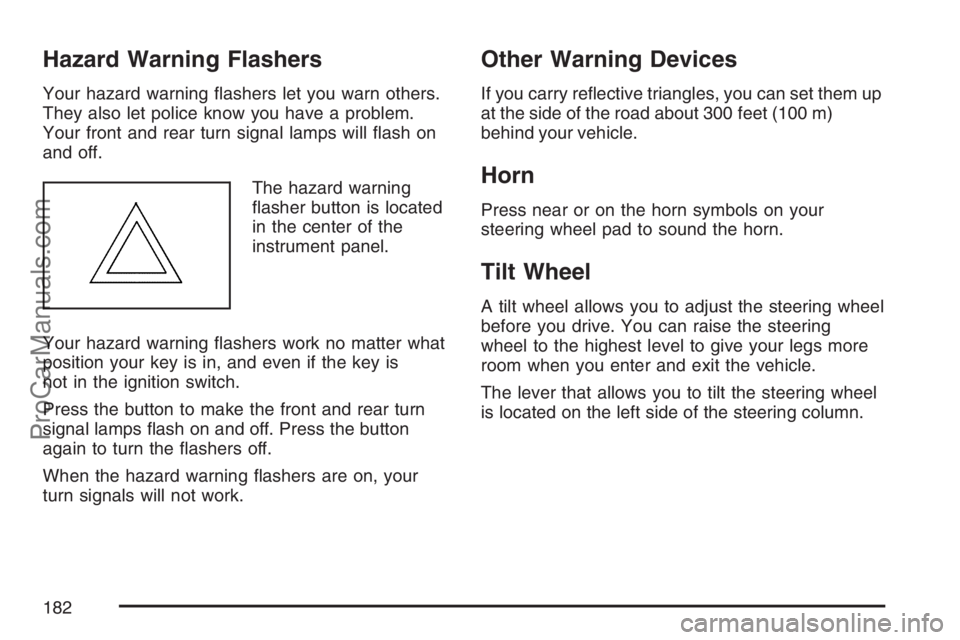ignition SATURN RELAY 2007 Owner's Manual
[x] Cancel search | Manufacturer: SATURN, Model Year: 2007, Model line: RELAY, Model: SATURN RELAY 2007Pages: 570, PDF Size: 3.41 MB
Page 140 of 570

Starting the Engine
Move your shift lever to PARK (P) or
NEUTRAL (N). Your engine will not start in
any other position — that is a safety feature.
To restart when you are already moving,
use NEUTRAL (N) only.
Notice:Shifting into PARK (P) with the
vehicle moving could damage the transaxle.
Shift into PARK (P) only when your vehicle
is stopped.
1. With your foot off the accelerator pedal,
turn your ignition key to START. When
the engine starts, let go of the key. The idle
speed will go down as your engine warms
up. Do not race the engine immediately
after starting it. Operate the engine and
transmission gently until the oil warms up
and lubricates all moving parts.Your vehicle has a Computer-Controlled
Cranking System. This feature assists in
starting the engine and protects the electrical
system. If the ignition key is turned to the
START position, and then released when the
engine begins cranking, the engine will
continue cranking until the vehicle starts or
until it exceeds the maximum cranking
time allowed, approximately 15 seconds to
prevent cranking motor damage. To prevent
starter-motor gear damage, this system
also prevents cranking if the engine is already
running. The engine cranking can be
stopped by turning the ignition switch to the
ACCESSORY or LOCK position.
Notice:Holding your key in START for longer
than 15 seconds at a time will cause your
battery to be drained much sooner. And the
excessive heat can damage your starter motor.
Wait about 15 seconds between each try to
help avoid draining your battery or damaging
your starter.
140
ProCarManuals.com
Page 143 of 570

Automatic Transaxle Operation
Maximum engine speed is limited when you are in
PARK (P) or NEUTRAL (N), to protect driveline
components from improper operation.
There are several different positions for your
shift lever.
PARK (P):This gear position locks your front
wheels. It is the best position to use when you start
your engine because your vehicle cannot move
easily.
Make sure the shift lever is fully in PARK (P)
before starting the engine. Your vehicle has an
automatic transaxle shift lock control system.
You must fully apply your regular brakes �rst and
then press the shift lever button before you can shift
from PARK (P) when the ignition key is in RUN.If you cannot shift out of PARK (P), ease pressure
on the shift lever and psh the shift lever all the way
info PARK (P) as you maintain brake application.
Then press the shift lever button and move the shift
lever into another gear. SeeShifting Out of Park (P)
on page 149.
{CAUTION:
It is dangerous to get out of your vehicle if
the shift lever is not fully in PARK (P) with
the parking brake �rmly set. Your vehicle
can roll.
Do not leave your vehicle when the engine
is running unless you have to. If you have
left the engine running, the vehicle can
move suddenly. You or others could be
injured. To be sure your vehicle will not
move, even when you are on fairly level
ground, always set your parking brake
and move the shift lever to PARK (P). See
Shifting Into Park (P) on page 148.Ifyou
are pulling a trailer, seeTowing a Trailer
on page 398.
143
ProCarManuals.com
Page 147 of 570

Parking Brake
The parking brake is
located under the
instrument panel on
the driver’s side of
the vehicle.
To set the parking brake, hold the regular brake
pedal down with your right foot and push down on
the parking brake pedal with your left foot.
If the ignition is on, the brake system warning light
will come on. SeeBrake System Warning Light
on page 226.To release the parking brake, hold the regular
brake pedal down with your right foot while
you push down on the parking brake pedal with
your left foot. When you lift your left foot from the
parking brake pedal, it will pop up to the
released position.
Notice:Driving with the parking brake on
can overheat the brake system and cause
premature wear or damage to brake system
parts. Verify that the parking brake is fully
released and the brake warning light is
off before driving.
If you are towing a trailer and are parking on any
hill, seeTowing a Trailer on page 398.
147
ProCarManuals.com
Page 148 of 570

Shifting Into Park (P)
{CAUTION:
It can be dangerous to get out of your
vehicle if the shift lever is not fully in
PARK (P) with the parking brake �rmly set.
Your vehicle can roll. If you have left the
engine running, the vehicle can move
suddenly. You or others could be injured.
To be sure your vehicle will not move, even
when you are on fairly level ground, use
the steps that follow. If you are pulling a
trailer, seeTowing a Trailer on page 398.
1. Hold the brake pedal down with your right foot
and set the parking brake with your left foot.
2. Move the shift lever into PARK (P) by pulling
the shift lever toward you and moving it up as
far as it will go.
3. Turn the ignition key to LOCK.
4. Remove the key and take it with you. If you
can leave your vehicle with the ignition key in
your hand, your vehicle is in PARK (P).
Leaving Your Vehicle With the
Engine Running
{CAUTION:
It can be dangerous to leave your vehicle
with the engine running. Your vehicle
could move suddenly if the shift lever is
not fully in PARK (P) with the parking
brake �rmly set. And, if you leave the
vehicle with the engine running, it could
overheat and even catch �re. You or
others could be injured. Do not leave your
vehicle with the engine running.
If you have to leave your vehicle with the engine
running, be sure your vehicle is in PARK (P)
and the parking brake is �rmly set before
you leave it. After you move the shift lever into
PARK (P), hold the regular brake pedal down.
Then, see if you can move the shift lever away
from PARK (P) without �rst pulling it toward you.
If you can, it means that the shift lever was
not fully locked into PARK (P).
148
ProCarManuals.com
Page 149 of 570

Torque Lock
If you are parking on a hill and you do not shift
your vehicle into PARK (P) properly, the weight
of the vehicle may put too much force on the
parking pawl in the transaxle. You may �nd
it difficult to pull the shift lever out of PARK (P).
This is called torque lock. To prevent torque
lock, set the parking brake and then shift into
PARK (P) properly before you leave the driver’s
seat. To �nd out how, seeShifting Into Park (P)
on page 148.
When you are ready to drive, move the shift
lever out of PARK (P) before you release the
parking brake.
If torque lock does occur, you may need to have
another vehicle push yours a little uphill to
take some of the pressure from the parking pawl
in the transaxle, so you can pull the shift lever
out of PARK (P).
Shifting Out of Park (P)
Your vehicle has an automatic transaxle shift lock
control system which locks the shift lever in
PARK (P) when the ignition is in the LOCK
position. In addition, you must fully apply your
regular brakes before you can shift from PARK (P)
when the ignition is in RUN. SeeAutomatic
Transaxle Operation on page 143.
149
ProCarManuals.com
Page 182 of 570

Hazard Warning Flashers
Your hazard warning �ashers let you warn others.
They also let police know you have a problem.
Your front and rear turn signal lamps will �ash on
and off.
The hazard warning
�asher button is located
in the center of the
instrument panel.
Your hazard warning �ashers work no matter what
position your key is in, and even if the key is
not in the ignition switch.
Press the button to make the front and rear turn
signal lamps �ash on and off. Press the button
again to turn the �ashers off.
When the hazard warning �ashers are on, your
turn signals will not work.
Other Warning Devices
If you carry re�ective triangles, you can set them up
at the side of the road about 300 feet (100 m)
behind your vehicle.
Horn
Press near or on the horn symbols on your
steering wheel pad to sound the horn.
Tilt Wheel
A tilt wheel allows you to adjust the steering wheel
before you drive. You can raise the steering
wheel to the highest level to give your legs more
room when you enter and exit the vehicle.
The lever that allows you to tilt the steering wheel
is located on the left side of the steering column.
182
ProCarManuals.com
Page 192 of 570

Erasing Speed Memory
When the cruise control or the ignition is turned
off, the cruise control set speed memory is erased.
Exterior Lamps
The control to the left of
the steering column
operates the exterior
lamps.
9(Off):Turn the control to this position to
toggle off all lamps. This is a momentary control
that will spring back to AUTO when released.
This momentary control will turn the automatic
headlamps and/or the Daytime Running Lamps on
and off for U.S. vehicles. For vehicles �rst sold
in Canada, this is only true when the transaxle is in
PARK (P).AUTO (Automatic):Turn the control to this
position to set your headlamps in automatic mode.
AUTO mode, if enabled, will turn the exterior
lamps on and off automatically depending on how
much light is available outside the vehicle.
Due to the momentary switch design, your
automatic lights may be disabled even if the
control is in the AUTO position.
;(Parking Lamps):Turn the control to this
position to turn on the parking lamps together with
the following:
Taillamps
Instrument Panel Lights
5(Headlamps):Turn the control to this position
to turn on the headlamps, together with the
previously listed lamps and lights.
192
ProCarManuals.com
Page 193 of 570

Wiper Activated Headlamps
This feature, if equipped, will automatically
activate the headlamps and parking lamps after
the windshield wipers have been in use for
about 30 seconds and when all of the following
conditions are met.
The exterior lamp control is in AUTO.
The headlamps have not already been
activated by automatic lighting.
The automatic lighting feature has not been
disabled using the exterior lamp control.
SeeExterior Lamps on page 192for additional
information.
If the wipers are activated for over 30 seconds
and the exterior lamp control is in the parking
lamps position, or the automatic lighting feature
has been disabled using the exterior lamp control,
a HEADLAMPS SUGGESTED message will
appear on the Driver Information Center, if
equipped.
Headlamps on Reminder
If you turn the ignition to LOCK while leaving the
lamps on, you will hear a warning chime once
the driver’s door is opened.
Daytime Running Lamps (DRL)/
Automatic Headlamp System
Daytime Running Lamps (DRL) can make it easier
for others to see the front of your vehicle during
the day. DRL can be helpful in many different
driving conditions, but they can be especially
helpful in the short periods after dawn and before
sunset. Fully functional Daytime Running Lamps
are required on all vehicles �rst sold in Canada.
193
ProCarManuals.com
Page 194 of 570

A light sensor on top of the instrument panel
makes the DRL work, so be sure it is not covered.
The DRL system will make front parking and
turn signal lamps come on in daylight when the
following conditions are met:
The ignition is on.
The exterior lamps control is off.
When the DRL are on, only your front turn signal
lamps will be on. Your instrument panel will
not be lit up.
When it is dark enough outside, the exterior lamps
will come on automatically. When it is bright
enough outside, the exterior lamps will turn off and
the DRL will turn on. Of course, you may still
turn on the headlamps any time you need to.If you start your vehicle in a dark garage, the
automatic headlamp system will come on
immediately. Once you leave the garage, it will
take approximately 30 seconds for the automatic
headlamp system to change to DRL if it is
light outside. During that delay, your instrument
panel cluster may not be as bright as usual. Make
sure your instrument panel brightness control is
in the full bright position. SeeInstrument
Panel Brightness on page 195.
To idle your vehicle with the DRL and automatic
headlamps off, toggle the exterior lamp control
to off after starting the vehicle.
As with any vehicle, you should turn on the
regular headlamp system when you need it.
194
ProCarManuals.com
Page 195 of 570

Instrument Panel Brightness
The knob to adjust the
instrument panel
brightness is located in
the center of the
interior lamp controls.
Turn the knob clockwise to brighten the lights and
counterclockwise to dim them.
Interior Lamps Control
The interior lamp control
is located to the right of
the exterior lamp
controls on the
instrument panel to the
left of the steering
column.
R(Interior Lamp Override):Turn the outer
knob to this position to have your interior lamps
remain off while any door is open.
1(Door):Turn the outer knob to this position to
turn the interior lamps on while any door is
open and when the ignition key is removed from
the ignition.
+(Interior Lamps):Turn the outer knob to
this position to turn the interior lamps on.
Turn the inner knob to adjust the instrument panel
brightness, described earlier in this section.
195
ProCarManuals.com